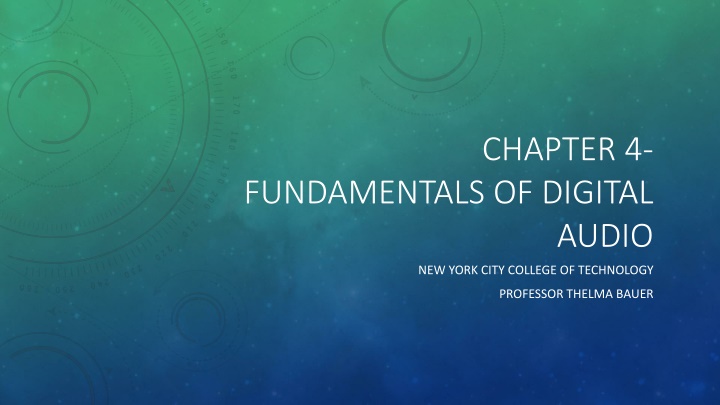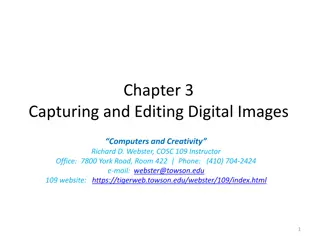
Sound Waves and Intensity in Digital Audio
Explore the fundamentals of digital audio, including how sound waves are generated, the relationship between sound frequency and pitch, the difference between sound intensity and loudness, and how sound propagates as a mechanical wave. Discover the objective measurement of sound intensity in decibels and the subjective perception of sound loudness.
Download Presentation

Please find below an Image/Link to download the presentation.
The content on the website is provided AS IS for your information and personal use only. It may not be sold, licensed, or shared on other websites without obtaining consent from the author. If you encounter any issues during the download, it is possible that the publisher has removed the file from their server.
You are allowed to download the files provided on this website for personal or commercial use, subject to the condition that they are used lawfully. All files are the property of their respective owners.
The content on the website is provided AS IS for your information and personal use only. It may not be sold, licensed, or shared on other websites without obtaining consent from the author.
E N D
Presentation Transcript
CHAPTER 4- FUNDAMENTALS OF DIGITAL AUDIO NEW YORK CITY COLLEGE OF TECHNOLOGY PROFESSOR THELMA BAUER
Sound is a wave that is generated by vibrating objects in a medium such as air. The vibrating objects can be the vocal cords of a person, a guitar string, or a tuning fork. An object vibrating in air creates a disturbance of the surrounding air molecules, causing periodic changes of air pressure forming a sound wave. No matter what the vibrating object is, the object is vibrating or moving back and forth at a certain frequency. This causes the surrounding air molecules to vibrate at this same frequency. The common unit for frequency is Hertz (Hz); 1 Hz refers to 1 cycle per second. The sound frequency is related to the pitch of the sound. Higher frequencies correspond to higher pitches.
Sound intensity is related to, but not exactly the same as, the perceived loudness of a sound. The loudness of a sound is a subjective perception, but sound intensity is an objective measurement. Sound intensity is often measured in decibels (dB). A decibel is based on a ratio of a louder sound to a softer one; it is not an absolute measurement. When two or more sound waves meet, their amplitudes add up, resulting in a more complex waveform. The waveforms of the sound we perceive every day (such as speech, music, and noise) are complex waveforms that result when multiple waveforms of different frequencies are added together.
Loudness Vs. Sound Intensity Like color, the loudness of a sound is a subjective perception and factors such as the age of the listener affects the subjective perception of sound. To measure loudness, a 1,000 Hz tone is used as a benchmark tone. The volume of this reference is adjusted until it is perceived as being as loud as the sound being measured. Sound intensity, on the other hand, can be measured objectively by auditory devices with no need for a listener. Sound intensity is measured in decibels. The threshold of pain is 120 decibels. Often, the higher the sound intensity the louder the sound is to the listener but not always.
SOUND AS A MECHANICAL WAVE Because the propagation of a sound wave in a medium relies on the mechanism of particle interactions, a sound wave is characterized as a mechanical wave. The implication of this property is that a sound wave does not propagate in a vacuum. The motion of a particle in a sound wave is parallel to the direction of the wave. This type of wave is characterized as a longitudinal wave. Notice that it is the motion of the particles that propagates, not the particles themselves. If you place a microphone in the path of the sound wave, the periodic air-pressure change will be detected by the recorder and converted into varying electrical signals. The changes of pressure in the propagating sound wave reaching the recorder are thus captured as changes of electrical signals over time. The sound wave can be represented graphically with the changes in air pressure or electrical signals plotted over time a waveform (Figure 4.1). The vertical axis of the waveform represents the relative air pressure or electrical signals caused by the sound wave. The horizontal axis represents time.
A vibrating guitar string in the air causes the string to move back and forth, causing periodic changes of air pressure. The changes of pressure in the propagating sound wave reaching the recorder are captured as changes of electrical signals over time. The sound wave can be represented graphically with the changes in air pressure or electrical signals plotted over time a waveform. Be careful not to interpret the waveform as a representation of the sound wave in space. The picture at the bottom here in Figure 4.1 is a picture of the air molecules in space. On the right is a graph over time. The air-pressure information at point B is not where time is zero on the waveform graph. Instead, the pressure information of point B has not yet propagated to the microphone; it would have been after point A has been recorded about three more cycles to the right of point A on the waveform.
A waveform is a graphical representation of the pressuretime (not pressure-space) fluctuations of a sound wave. A sound wave propagates in space. The waveform matches the pressure changes in time at a fixed location. The crests correspond to the high pressure (compression of air molecules), and troughs correspond to the low pressure (rarefaction). The horizontal axis is time. However, looking at an illustration of a longitudinal pressure wave of sound placed side by side with its waveform can mislead you to think of the horizontal axis of the waveform as distance if you are not careful. Remember that the horizontal axis of a wave-form is time, not distance. Let s re-emphasize two key points about a waveform: 1. Be careful not to interpret sound wave as a wave that has crests and troughs, as in a transverse wave. Sound wave is a longitudinal wave, in which the particles of the medium (such as air molecules) move back and forth, not up and down, in the direction of the wave propagation. 2. Be careful not to interpret the waveform as a representation of the sound wave in space. Instead, the waveform graph represents the pressure changes over time. Besides visualization of the pressure oscillation of the sound wave over time, a wave- form can also give us information about the pitch and loudness of the sound. The following sections discuss how these two properties are measured and derived from the Waveform.
Frequency and Pitch A sound wave is produced by a vibrating object in a medium, say air. No matter what the vibrating object is, it is vibrating or moving back and forth at a certain frequency. This causes the surrounding air molecules to vibrate at this same frequency, sending out the sound-pressure wave. The frequency of a wave refers to the number of complete back-and- forth cycles of vibrational motion of the medium particles per unit of time. The common unit for frequency is Hertz (Hz) where the unit of time is 1 second. 1 Hz =1 cycle/second Sound frequency is related to the pitch of the sound. Higher frequencies correspond to higher pitches. Generally speaking, the human ear can hear sound ranging from 20 Hz to 20,000 Hz. Sound Intensity and Loudness Sound intensity is related to the perceived loudness of a sound, but the two are not exactly the same. Sound intensity is often measured in decibels (dB). A decibel is based on a ratio of a louder sound to a softer one.
Images show Amplitude vs Frequency Sound frequency and the pitch of a sound are linked. Higher frequencies = higher pitches. Human ear hears song ranging from 20 Hz to 20,000 Hz.
LOUDNESS VERSUS SOUND INTENSITY The loudness of a sound is a subjective perception, but sound intensity is an objective measurement. Thus, loudness and sound intensity are not exactly the same properties. To measure loudness, a 1,000-Hz tone is used as a reference tone. The volume of the reference tone is adjusted until it is perceived by listeners to be equally as loud as the sound being measured. Sound intensity, on the other hand, can be measured objectively by auditory devices independent of a listener. The age of the listener is one of the factors that affect the subjective perception of a sound. The frequency of the sound is also a factor because of the human ear s sensitivity to different sound frequencies. The loudness of sound (as perceived by human ears) is only roughly proportional to the logarithm of sound intensity. However, in general, the higher the sound intensity, the louder the sound is perceived.
ADDING SOUND WAVES A simple sine wave waveform represents a simple single tone single frequency. When two or more sound waves meet, their amplitudes add up, resulting in a more complex waveform (Figure 4.3). The sound we perceive every day is seldom a single tone. The waveforms representing speech, music, and noise are complex waveforms that result from adding multiple waveforms of different frequencies. For example, Figure 4.4 shows a waveform of the spoken word one.
DECOMPOSING SOUND When we record a sound, such as the spoken word one in Figure 4.4, the waveform recorded is a complex one. Can a complex wave be decomposed into its simple component parts the different sine waves that make up the complex wave? Yes! One of the mathematical methods to accomplish this decomposition is called the Fourier transform. But why would you want to decompose a complex wave into simple sine waves? The frequency of a simple sine wave can be determined easily. When you want to remove certain sounds that can be characterized by a range of frequencies, such as low-pitched noise, you can apply filters using the Fourier transform to selectively remove these unwanted sounds from a complex sound. These filters are available in many digital audio processing programs and are used for breaking down a sound to remove unwanted frequencies.
Like the process of digitizing any analog information, the process of digitizing a sound wave involves sampling and quantizing an analog sound wave. In the sampling step, the sound wave is sampled at a specific rate into discrete samples of amplitude values. The higher the sampling rate, the higher the accuracy in capturing the sound. But a high sampling rate will generate more sample points, which will require more storage space and processing time. In the quantizing step, each of the discrete samples of amplitude values obtained from the sampling step will be mapped to the nearest value on a scale of discrete levels. Therefore, the more levels available in the scale, the higher the accuracy in reproducing the sound. For digital audio, having more levels means higher resolution. But higher resolution requires more storage space for the same reason that higher bit depth for any digital media will increase the file size.
Audio files, such as speech and music, usually require long, continuous playback. Therefore, the file size increases very rapidly with higher sampling rate and bit depth. To reduce the file size, there are four general file optimization approaches: reduce the sampling rate, reduce the bit depth, apply compression, and reduce the number of channels. No matter which file size reduction strategies you want to apply to your audio file, you should always evaluate the acceptability of the audio quality of the reduced file based on the nature of your audio project, and weigh the quality against the file size limitation. The intended use of your final audio dictates the consideration of the acceptable tradeoffs. Even working within a limitation of file size, you will get better results by recording or digitizing at a sampling rate and bit depth that produce good audio quality and then apply file size reduction strategies later.
Reducing the number of channels. Stereo audio has two channels. If you reduce a stereo audio file to mono which becomes one channel then you reduce the file size in half. This may suit speech and short sound effects for online games. Your decision to reduce the audio from stereo to mono is very much dependent on the nature of your project. Reducing a channel causes a noticeable difference unless your final product is expected to be listened to with a mono-speaker. When reducing the sampling rate, according to a rule called Nyquist s theorem, we must sample at least two points in each sound wave cycle to be able to reconstruct the sound wave satisfactorily. In other words, the sampling rate of the audio must be at least twice that of the audio frequency called a Nyquist rate. Therefore, a higher-pitch sound requires a higher sampling rate than a lower-pitch sound. In reality, the sound we hear, such as music and speech, is made up of multiple- frequency components. Then the sampling rate can be chosen as twice the highest-frequency component in the sound in order to reproduce the audio satisfactorily. Reducing the sampling rate sacrifices the sound quality of the higher frequencies. Sampling at many times per cycle Nyquist rate -- For lossless digitization, the sampling rate should be at least twice the maximum frequency responses. Indeed many times more the better. Sampling at 2 times per cycle
Reducing the bit depth. The most common bit-depth settings you may encounter in a digital audio editing program are 8 bit and 16 bit. According to the file size equation, lowering the bit depth from 16 to 8 reduces the file size in half. In the example of a 1-minute CD- quality stereo audio, lowering the bit depth from 16 to 8 will reduce the file size from about 10 MB to about 5 MB. Suppose the sampling rate of the audio has been lowered from 44.1 kHz to 22.05 kHz, creating a 5-MB file. Lowering the bit depth of this file from 16 to 8 will reduce the file size further, from 5 MB to 2.5 MB. Eight-bit resolution is usually sufficient for speech. However, for music, 8-bit resolution is too low to accurately reproduce the sound satisfactorily. Our ears usually can notice the degradation in playback. Typically, 16-bit resolution is used for music.
Applying file compression. An audio file can be compressed to reduce the audio file size. Compression can be lossless or lossy. Lossy compression gets rid of some data, but human perception is taken into consideration so that the data removed causes the least noticeable distortion. For example, the popular audio file format MP3 uses a lossy compression that gives a good compression rate while preserving the perceptible quality of the audio by selectively removing the least perceptible frequency components of the audio. Keep in mind that a file compressed with a lossy compression method should not be used as a source file for further editing. To achieve the best result in editing an audio file, you should always start with a source file that is uncompressed or compressed with lossless compression.
CLOUD COMPUTING FOR VIDEO AND AUDIO DELIVERY The term cloud refers to the Internet and cloud computing refers to the technologies that provide computing services (such as storage, software, database access) to users via the Internet. For online storage, you can download your files onto your devices whenever needed. The downloaded video and audio files can be played back from your devices. For video and audio files, cloud-based service providers often also support streaming the media the media is played back over the Internet. For example, Amazon Cloud Drive offers online storage and supports downloading and streaming of music files that are saved on your Cloud Drive. Apple iCloud lets you stream the music files stored on your iCloud and download them on any of your devices.
Another method of storing music information is in MIDI format. MIDI stands for Musical Instrument Digital Interface. MIDI files do not contain digitized audio sample points. Instead, they contain information about musical notes to be played with a virtual instrument. Such information includes the instrument being played, the note being played, the duration of the note, and how loud to play the note. Unlike digitized audio, MIDI music creation does not involve digitizing analog sound waves or any analog information. Therefore, there are no sampling rate and bit depth settings. MIDI music has the advantage of very small file size. Another advantage is that the music content can be edited easily. The disadvantage is that the sound depends on the synthesizer that plays back the composed music. Thus, you do not know how your MIDI file sounds on your target audience s devices.






















